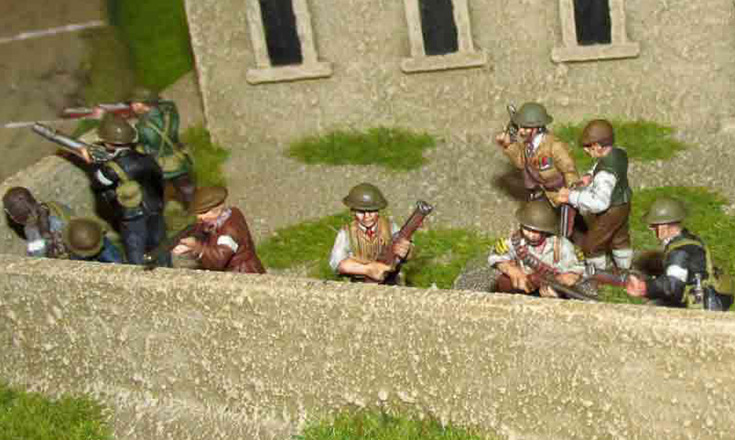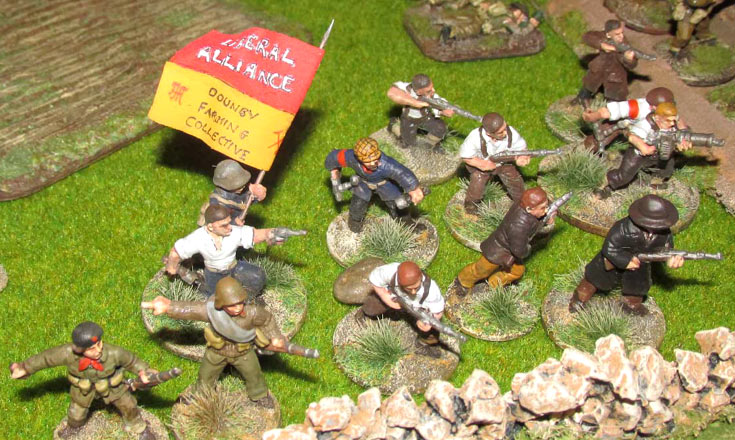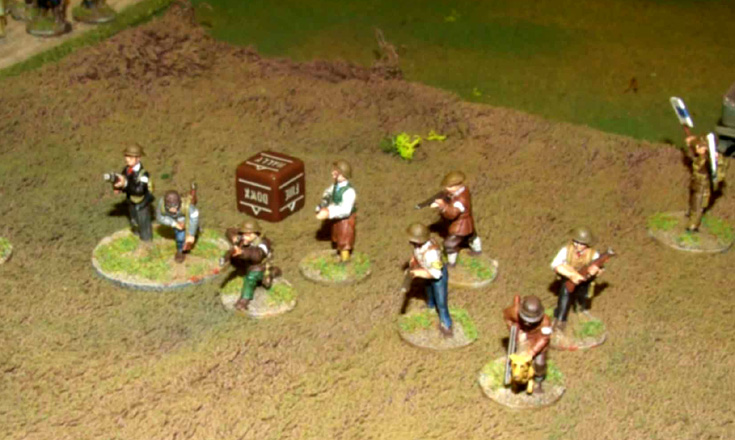
Clash in Rendall, Orkney, 1936
18th September 2014, 0 Comments
A Very British Civil War, Chain of Command, 28mm
This week we played a Very British Civil War game, a fictional conflict set in Britain during the late 1930’s. Our version of it is set up here in Orkney, and pits the forces loyal to King Edward VIII against those who have declared for his brother, Prince Albert. Frankly it felt a little strange playing this, at a time when Scotland is deeply divided into two irreconcilable fractions, and the very future of Great Britain hangs in the balance. The difference is of course, that this game is entirely fictional, and I don’t really care which side I play on. In the real battle for Scotland, a political struggle being fought at this very moment, then I care very deeply indeed. The divisions caused by this independence referendum have given me a fresh insight into the fictional divisions we game here. Let’s just hope that whatever side wins the losing faction will accept the decision, and won’t resort to the political and military anarchy we’re gaming here.  Right. Enough of the soap box. Back to the game. This was a clash between two advancing forces, set somewhere in Rendall, a parish on the north-western part of the Orkney mainland. It lies between the two strongholds in the area – Dounby for the Albertines (home of the Dounby Farmers’ Collective) and Finstown (forward base of the Orkney Militia). Both sides sent out strong patrols, and clashed near the Redland Church (Rev. Jimmy Tait). The Edwardian force consisted of four sections of Orkney Territorials, two of Orkney police and paramilitaries (the Dark Islanders), and a section of County Militia. they were backed up by an armoured car, and a couple of machine guns. For their part the Albertines had three sections of Naval Landing Party, two of Royal Marines, two of the Dounby Farmers’ collective, and a section of Stromness Communists. Their support consisted of a Universal Carrier, a 3-inch mortar and a machine gun.
Right. Enough of the soap box. Back to the game. This was a clash between two advancing forces, set somewhere in Rendall, a parish on the north-western part of the Orkney mainland. It lies between the two strongholds in the area – Dounby for the Albertines (home of the Dounby Farmers’ Collective) and Finstown (forward base of the Orkney Militia). Both sides sent out strong patrols, and clashed near the Redland Church (Rev. Jimmy Tait). The Edwardian force consisted of four sections of Orkney Territorials, two of Orkney police and paramilitaries (the Dark Islanders), and a section of County Militia. they were backed up by an armoured car, and a couple of machine guns. For their part the Albertines had three sections of Naval Landing Party, two of Royal Marines, two of the Dounby Farmers’ collective, and a section of Stromness Communists. Their support consisted of a Universal Carrier, a 3-inch mortar and a machine gun. As this was a Chain of Command encounter game, we began by moving our “Patrol Markers” forward, then siting our “Jump Off Points”. We use little piles of oil drums to mark the locations of these – the places where our troops can deploy. This means that they start fairly close to the enemy, and avoids long periods where both sides advance onto the table. By the end of the first two turns the front lines had been established – the Edwardians to the south of the lateral Woodwick road crossing the table, and the Albertines to the north, near the farm of Quoys.
As this was a Chain of Command encounter game, we began by moving our “Patrol Markers” forward, then siting our “Jump Off Points”. We use little piles of oil drums to mark the locations of these – the places where our troops can deploy. This means that they start fairly close to the enemy, and avoids long periods where both sides advance onto the table. By the end of the first two turns the front lines had been established – the Edwardians to the south of the lateral Woodwick road crossing the table, and the Albertines to the north, near the farm of Quoys. In between lay as big cornfield (for some reason are Orkney battles always seem to be fought in August, before the harvest), and two hilly patches of moorland. the navy deployed on the left, the Dounby Farmers in the centre, and the Marines on the right. Facing them the Territorials were in the centre behind the cornfield with the rest of the Edwardians force deployed on their flanks.
In between lay as big cornfield (for some reason are Orkney battles always seem to be fought in August, before the harvest), and two hilly patches of moorland. the navy deployed on the left, the Dounby Farmers in the centre, and the Marines on the right. Facing them the Territorials were in the centre behind the cornfield with the rest of the Edwardians force deployed on their flanks. The Albertines began their attack, with a left hook across the high ground – Vishall Hill – on their left hand flank. Just off the table edge was the water of Eynhallow Sound, which meant their left flank was secure. The Albertines largely ignored the high ground to the right, where the small road crossed the hills to Dounby. In the centre the fire of the Territorials proved too much for the leading section of Royal Marines, who suffered casualties before pulling back to the farm. A long-range firefight then developed, with both sides wary of advancing any further.
The Albertines began their attack, with a left hook across the high ground – Vishall Hill – on their left hand flank. Just off the table edge was the water of Eynhallow Sound, which meant their left flank was secure. The Albertines largely ignored the high ground to the right, where the small road crossed the hills to Dounby. In the centre the fire of the Territorials proved too much for the leading section of Royal Marines, who suffered casualties before pulling back to the farm. A long-range firefight then developed, with both sides wary of advancing any further. To break the stalemate the Edwardians deployed their armoured car – “Earl Sigurd”, which ran down a side road, and shot up the flank of the men on Vishall Hill. Their first target was the Royal Marine mortar team which had been plastering the Territorials. With it silenced the Albertines were unable to deal with the Rolls Royce car – their only counter was the Universal Carrier with its Boyes Rifle, and it was on the far side of the hill.
To break the stalemate the Edwardians deployed their armoured car – “Earl Sigurd”, which ran down a side road, and shot up the flank of the men on Vishall Hill. Their first target was the Royal Marine mortar team which had been plastering the Territorials. With it silenced the Albertines were unable to deal with the Rolls Royce car – their only counter was the Universal Carrier with its Boyes Rifle, and it was on the far side of the hill. Still, that advance went well, and as the sailors and farm militia crested the hill they opened up on the policemen deployed in front of them. The firefight was pretty evenly matched until the carrier came up, and its Bren Gun tipped the balance, and the police were forced to hunker down and hold on, pinned behind a stone wall, the truck behind them riddled with bullets. Over on the far right another tentative advance again, with the remains of the Marines, backed up by a section of sailors. This time they advanced up the right side of the main Birsay to Evie main road, heading towards the Redland Church. Once there they could fire into the flank of the Territorials. Guarding that flank was a detachment of the Dark Islanders, backed up by a Territorial machine gun. Until they were dealt with the advance would be going nowhere.
Still, that advance went well, and as the sailors and farm militia crested the hill they opened up on the policemen deployed in front of them. The firefight was pretty evenly matched until the carrier came up, and its Bren Gun tipped the balance, and the police were forced to hunker down and hold on, pinned behind a stone wall, the truck behind them riddled with bullets. Over on the far right another tentative advance again, with the remains of the Marines, backed up by a section of sailors. This time they advanced up the right side of the main Birsay to Evie main road, heading towards the Redland Church. Once there they could fire into the flank of the Territorials. Guarding that flank was a detachment of the Dark Islanders, backed up by a Territorial machine gun. Until they were dealt with the advance would be going nowhere. Another firefight developed, and this time the Marines’ superior training won the day. The Dark Islanders were badly shot up, and forced to pull back. The machine gun was silenced too. However, all wasn’t going smoothly, as in the centre the Territorials were doing well in their firefight until the farmhouse caught fire. Denied its cover, they became more vulnerable to enemy fire. Then, the “Earl Sigurd” was hit by the Boyes anti-tank rifle, the carrier having trundled up to the brow of the hill and fired on it as it drove past down below. The crew were lucky, and recieved a shock. However, it was clear they were now very exposed, and the Rolls Royce retired back up the road, covered by fire from the remaining Territorial machine gun.
Another firefight developed, and this time the Marines’ superior training won the day. The Dark Islanders were badly shot up, and forced to pull back. The machine gun was silenced too. However, all wasn’t going smoothly, as in the centre the Territorials were doing well in their firefight until the farmhouse caught fire. Denied its cover, they became more vulnerable to enemy fire. Then, the “Earl Sigurd” was hit by the Boyes anti-tank rifle, the carrier having trundled up to the brow of the hill and fired on it as it drove past down below. The crew were lucky, and recieved a shock. However, it was clear they were now very exposed, and the Rolls Royce retired back up the road, covered by fire from the remaining Territorial machine gun. That was pretty much where the game came to an end. We’d started late, and it was now almost 11pm, and time to pack up. The game was pretty clearly a draw, but the Albertines were slowly regaining their momentum, having suffered badly in the first few turns. The game could have gone either way, particularly as the Edwardians still had a better position, but we decided to recall both forces, so they could live to fight another day. Casualties on both sides were fairly even – about 25% of each force – which was pretty bloody for a Chain of Command game. We all had good fun though, and vowed to work a little on raising more Orlney forces, and Orkney scenery. If anyone knows where I can find figures suitable for the Boys Brigade, c. 1937, then please let me know!
That was pretty much where the game came to an end. We’d started late, and it was now almost 11pm, and time to pack up. The game was pretty clearly a draw, but the Albertines were slowly regaining their momentum, having suffered badly in the first few turns. The game could have gone either way, particularly as the Edwardians still had a better position, but we decided to recall both forces, so they could live to fight another day. Casualties on both sides were fairly even – about 25% of each force – which was pretty bloody for a Chain of Command game. We all had good fun though, and vowed to work a little on raising more Orlney forces, and Orkney scenery. If anyone knows where I can find figures suitable for the Boys Brigade, c. 1937, then please let me know!




